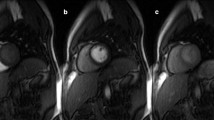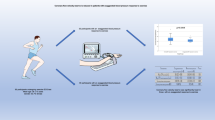Abstract
Endothelial dysfunction is a key element in early atherogenesis. The purposes of this study were to evaluate the feasibility of magnetic resonance (MR) assessment of altered myocardial blood flow (MBF) in response to the cold pressor test (CPT) and to determine if coronary endothelial dysfunction in young smokers can be detected with this noninvasive approach. Fourteen healthy non-smokers (31 ± 6 years) and 12 smokers (34 ± 8 years) were studied. Breath-hold phase-contrast cine MR imaging (PC-MRI) of the coronary sinus (CS) were obtained at rest and during the CPT. MBF was measured as CS flow divided by left ventricle mass and the rate pressure product. In non-smokers, MBF was 0.88 ± 0.19 ml/min/g at rest and significantly increased to 1.13 ± 0.26 ml/min/g during the CPT (P = 0.0001). In smokers, MBF was 0.94 ± 0.26 ml/min/g at rest and 0.96 ± 0.30 ml/min/g during the CPT (P = 0.73). ΔMBF (MBF during the CPT–MBF at rest) was significantly reduced in smokers compared with non-smokers (0.02 ± 0.20 vs. 0.26 ± 0.18 ml/min/g, P = 0.005). The intra-class correlation coefficient between measurements by two observers was 0.90 for ΔMBF. A significant reduction in MBF response to CPT was demonstrated in young smokers with PC-MRI at 1.5 T. This noninvasive method has great potential for assessment of coronary endothelial function.






Similar content being viewed by others
References
Vallance P, Chan N (2001) Endothelial function and nitric oxide: clinical relevance. Heart 85(3):342–350
Vanhoutte PM (2003) Endothelial control of vasomotor function: from health to coronary disease. Circ J 67(7):572–575
Halcox JP, Schenke WH, Zalos G et al (2002) Prognostic value of coronary vascular endothelial dysfunction. Circulation 106(6):653–658
Suwaidi JA, Hamasaki S, Higano ST et al (2000) Long-term follow-up of patients with mild coronary artery disease and endothelial dysfunction. Circulation 101(9):948–954
Higashi Y, Noma K, Yoshizumi M et al (2009) Endothelial function and oxidative stress in cardiovascular diseases. Circ J 73(3):411–418
Kirma C, Akcakoyun M, Esen AM et al (2007) Relationship between endothelial function and coronary risk factors in patients with stable coronary artery disease. Circ J 71(5):698–702
Ambrose JA, Barua RS (2004) The pathophysiology of cigarette smoking and cardiovascular disease: an update. J Am Coll Cardiol 43(10):1731–1737
Benowitz NL (2003) Cigarette smoking and cardiovascular disease: pathophysiology and implications for treatment. Prog Cardiovasc Dis 46(1):91–111
Hill JM, Zalos G, Halcox JP et al (2003) Circulating endothelial progenitor cells, vascular function and cardiovascular risk. N Engl J Med 348(7):593–600
Nitenberg A, Paycha F, Ledoux S et al (1998) Coronary artery responses to physiological stimuli are improved by deferoxamine but not by l-arginine in non-insulin-dependent diabetic patients with angiographically normal coronary arteries and no other risk factors. Circulation 97(8):736–743
Nabel EG, Ganz P, Gordon JB et al (1988) Dilation of normal and constriction of atherosclerotic coronary arteries caused by the cold pressor test. Circulation 77(1):43–52
Monahan KD, Feehan RP, Sinoway LI et al (2013) Contribution of sympathetic activation to coronary vasodilatation during the cold pressor test in healthy men: effect of ageing. J Physiol 591(Pt 11):2937–2947
Hwang HJ, Youn HJ, Lee MY et al (2012) Change of coronary flow velocity during the cold pressor test is related to endothelial markers in subjects with chest pain and a normal coronary angiogram. Clin Cardiol 35(2):119–124
Antony I, Aptecar E, Lerebours G et al (1994) Coronary artery constriction caused by the cold pressor test in human hypertension. Hypertension 24(2):212–219
Nitenberg A, Valensi P, Sachs R et al (2004) Prognostic value of epicardial coronary artery constriction to the cold pressor test in type 2 diabetic patients with angiographically normal coronary arteries and no other major coronary risk factors. Diabetes Care 27(1):208–215
van Rossum AC, Visser FC, Hofman MB et al (1992) Global left ventricular perfusion: noninvasive measurement with cine MR imaging and phase velocity mapping of coronary venous outflow. Radiology 182(3):685–691
Hood WB Jr (1968) Regional venous drainage of the human heart. Br Heart J 30(1):105–109
Kawada N, Sakuma H, Yamakado T et al (1999) Hypertrophic cardiomyopathy: MR measurement of coronary blood flow and vasodilator flow reserve in patients and healthy subjects. Radiology 211(1):129–135
Lund GK, Watzinger N, Saeed M et al (2003) Chronic heart failure: global left ventricular perfusion and coronary flow reserve with velocity-encoded cine MR imaging: initial results. Radiology 227(1):209–215
Watzinger N, Lund GK, Saeed M et al (2005) Myocardial blood flow in patients with dilated cardiomyopathy: quantitative assessment with velocity-encoded cine magnetic resonance imaging of the coronary sinus. J Magn Reson Imaging 21(4):347–353
Maroules CD, Chang AY, Kontak A et al (2010) Measurement of coronary flow response to cold pressor stress in asymptomatic women with cardiovascular risk factors using spiral velocity-encoded cine MRI at 3 T. Acta Radiol 51(4):420–426
Semelka RC, Tomei E, Wagner S et al (1990) Normal left ventricular dimensions and function: interstudy reproducibility of measurements with cine MR imaging. Radiology 174(3 Pt 1):763–768
Koskenvuo JW, Hartiala JJ, Knuuti J et al (2001) Assessing coronary sinus blood flow in patients with coronary artery disease: a comparison of phase-contrast MR imaging with positron emission tomography. Am J Roentgenol 177(5):1161–1166
Naya M, Tsukamoto T, Morita K et al (2007) Olmesartan, but not amlodipine, improves endothelium-dependent coronary dilation in hypertensive patients. J Am Coll Cardiol 50(12):1144–1149
Siegrist PT, Gaemperli O, Koepfli P et al (2006) Repeatability of cold pressor test-induced flow increase assessed with H(2)(15)O and PET. J Nucl Med 47(9):1420–1426
Bland JM, Altman DG (1986) Statistical methods for assessing agreement between two methods of clinical measurement. Lancet 1(8476):307–310
Deanfield JE, Halcox JP, Rabelink TJ (2007) Endothelial function and dysfunction: testing and clinical relevance. Circulation 115(10):1285–1295
Schindler TH, Nitzsche EU, Munzel T et al (2003) Coronary vasoregulation in patients with various risk factors in response to cold pressor testing: contrasting myocardial blood flow responses to short- and long-term vitamin C administration. J Am Coll Cardiol 42(5):814–822
Morita K, Tsukamoto T, Naya M et al (2006) Smoking cessation normalizes coronary endothelial vasomotor response assessed with 15O-water and PET in healthy young smokers. J Nucl Med 47(12):1914–1920
Alexanderson E, Rodriguez-Valero M, Martinez A et al (2009) Endothelial dysfunction in recently diagnosed type 2 diabetic patients evaluated by PET. Mol Imaging Biol 11(1):1–5
Schwitter J, DeMarco T, Kneifel S et al (2000) Magnetic resonance-based assessment of global coronary flow and flow reserve and its relation to left ventricular functional parameters: a comparison with positron emission tomography. Circulation 101(23):2696–2702
Moro PJ, Flavian A, Jacquier A et al (2011) Gender differences in response to cold pressor test assessed with velocity-encoded cardiovascular magnetic resonance of the coronary sinus. J Cardiovasc Magn Reson 13:54
Hwang KH, Lee BI, Kim SJ et al (2009) Evaluation of coronary endothelial dysfunction in healthy young smokers: cold pressor test using [(15)O]H(2)O PET. Appl Radiat Isot 67(7–8):1199–1203
Schindler TH, Facta AD, Prior JO et al (2007) Improvement in coronary vascular dysfunction produced with euglycaemic control in patients with type 2 diabetes. Heart 93(3):345–349
Hofman MB, Visser FC, van Rossum AC et al (1995) In vivo validation of magnetic resonance blood volume flow measurements with limited spatial resolution in small vessels. Magn Reson Med 33(6):778–784
Czernin J, Waldherr C (2003) Cigarette smoking and coronary blood flow. Prog Cardiovasc Dis 45(5):395–404
Naya M, Morita K, Yoshinaga K et al (2011) Long-term smoking causes more advanced coronary endothelial dysfunction in middle-aged smokers compared to young smokers. Eur J Nucl Med Mol Imaging 38(3):491–498
Acknowledgments
The authors would like to thank the Advanced School for Core Investigators program organized by the Asian Society of Cardiovascular Imaging for providing valuable suggestions and comments on our research.
Conflict of interest
The authors report no conflicts of interest.
Author information
Authors and Affiliations
Corresponding author
Rights and permissions
About this article
Cite this article
Ichikawa, Y., Kitagawa, K., Kato, S. et al. Altered coronary endothelial function in young smokers detected by magnetic resonance assessment of myocardial blood flow during the cold pressor test. Int J Cardiovasc Imaging 30 (Suppl 1), 73–80 (2014). https://doi.org/10.1007/s10554-014-0387-y
Received:
Accepted:
Published:
Issue Date:
DOI: https://doi.org/10.1007/s10554-014-0387-y




